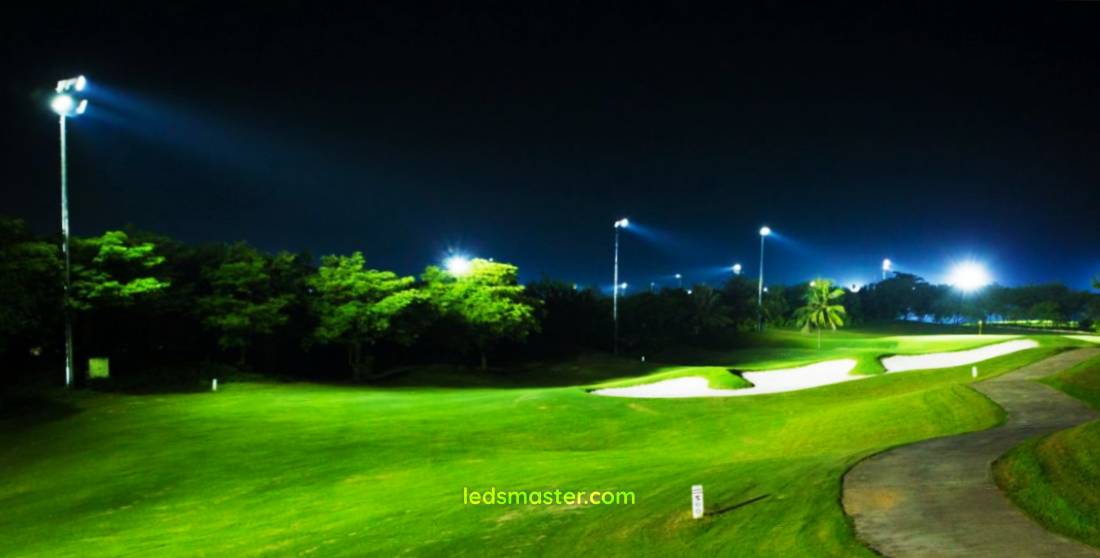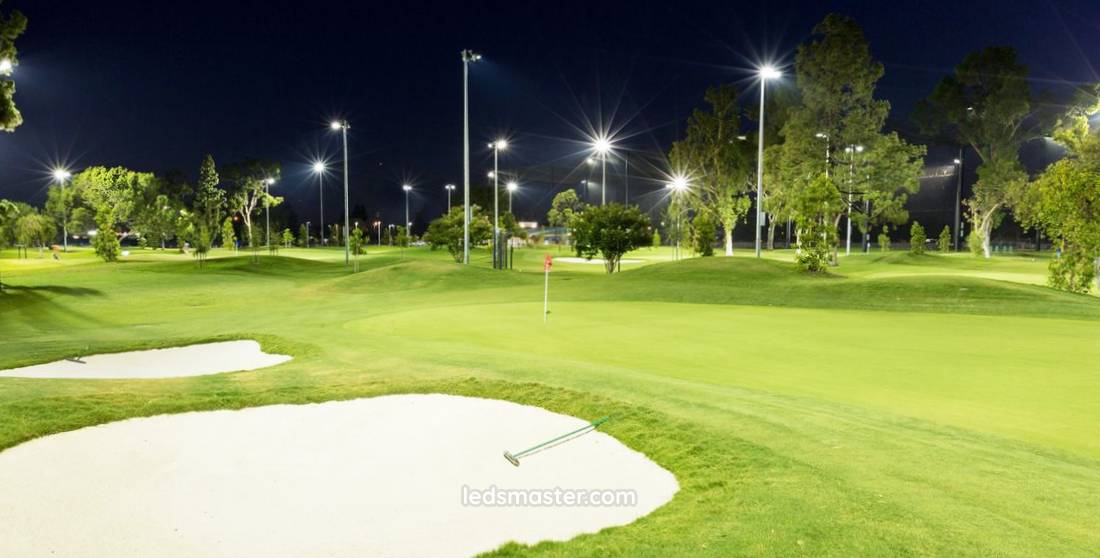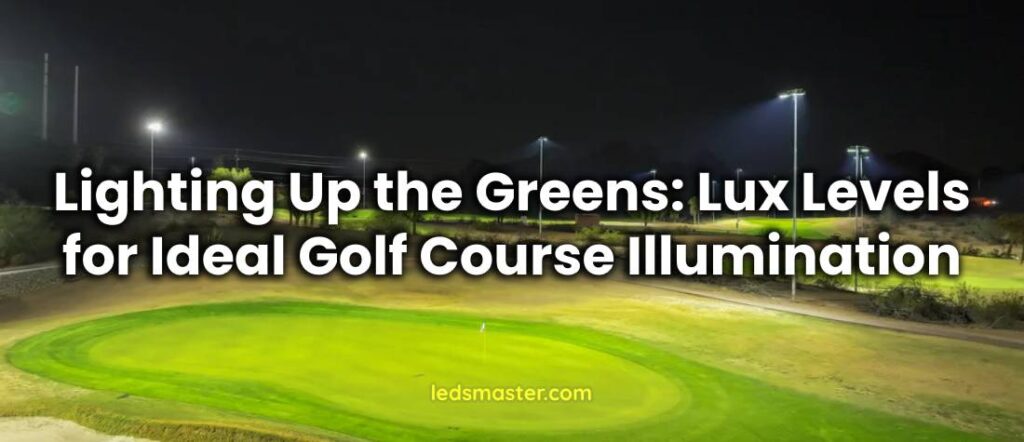Golf is a sport that requires not just skill but also the ability to assess the environment, read the course, and make precise decisions based on the visibility of the terrain. Whether golfers are playing during the early morning, late evening, or under overcast skies, visibility becomes a central challenge. When natural light fades, or when certain parts of the course are obscured by fog, adequate artificial lighting is necessary to maintain safety, performance, and overall enjoyment. For golf course managers and lighting designers, understanding lux levels is crucial to providing the right kind of illumination that meets the needs of players. Lux refers to the measurement of light intensity on a surface, and when it comes to golf courses, ensuring the correct lux levels in different areas can vastly improve the playing experience. Achieving optimal lighting across the course, while avoiding excessive glare or dimly lit areas, is fundamental to designing an effective and practical lighting system.
| Area of the Golf Course | Recommended Lux Levels | Description |
|---|---|---|
| Tees and Fairways | 100 – 150 lux | Adequate lighting to line up shots, assess distances, and avoid dark spots or uneven light distribution across the expansive areas of tees and fairways. |
| Greens | 200 – 300 lux | Proper lighting to read slopes, contours, and ball movement, with even illumination to avoid harsh contrasts and glare that could disrupt play. |
| Hazards and Bunkers | 50 – 100 lux | Subtle lighting to highlight the boundaries and contours of sand traps, water features, and roughs without distracting from the fairway or greens. |
| Water Features | 30 – 50 lux | Soft, subtle lighting around ponds, lakes, and streams to help golfers assess their proximity without creating glare or excessive brightness. |
Table of Contents
ToggleLux Requirements for Specific Areas of the Golf Course
Golf courses are divided into several sections, each with different lighting requirements. To achieve optimal visibility and performance, tailor the lux levels to specific areas of the course. The following areas are among the most important when establishing the appropriate lighting.

Tees and Fairways
Tees and fairways are where golfers spend a majority of their time, making proper lighting essential for maintaining a high-quality playing experience. Tees mark the start of each hole, and golfers need adequate illumination to line up their shots, gauge the distance, and assess any potential obstacles in their way. Fairways, which stretch across large distances, require lighting that covers the entire length of the area to ensure no dark spots are present and that light distribution is even.
Recommended Lux Levels for Tees and Fairways
The ideal lux levels for tees and fairways typically range from 100 lux to 150 lux. This range provides sufficient illumination for golfers to see the ball, judge the terrain, and track their shots. The lighting also needs to minimize excessive glare that could affect focus and accuracy. Fairways, due to their expansive nature, require careful design to distribute light evenly, ensuring that no areas are too bright or too dark. In large open areas, it’s important to maintain uniform lighting, as uneven light can confuse players, making navigation difficult.
Greens
Greens need to be illuminated properly to ensure that players can read the slopes, contours, and subtle variations of the surface to make accurate putts. Illumination also assists in judging the way the ball will roll, which directly affects a player’s strategy and performance. Without proper lighting, it would be difficult to assess these delicate aspects of the green, which can result in mistakes and frustration.
Ideal Lux Levels for Greens
For the greens, the lux levels should typically fall between 200 lux and 300 lux. This amount of light ensures that the golfer can clearly see the details of the green’s surface, such as undulations or small imperfections, while avoiding excessive brightness that could lead to harsh contrasts and distracting shadows. The goal is to provide even illumination across the entire green. Harsh lighting could cause glare, making it harder for players to focus on the ball and the hole. On the other hand, insufficient lighting can cause the ball’s behavior to be difficult to predict, resulting in poor performance.
Hazards and Bunkers
Hazards, such as sand traps, water features, and roughs, are designed to challenge golfers and shape their strategy. Proper illumination in these areas is necessary to help golfers avoid these obstacles or navigate them safely. However, the lighting in hazard areas should be subtle and not overpower the rest of the course. The objective is to highlight the features of the hazard without creating distractions that would pull attention away from the game.
Managing Lux Levels in Hazard Areas
In hazard areas, lux levels should range from 50 lux to 100 lux. These levels are low enough to keep the lighting from overwhelming the player’s perception of the course while ensuring that the boundaries and features of the hazards are visible. For example, sand traps require enough illumination to make the edges and depth of the trap visible. However, too much light could make the trap too prominent, overshadowing the fairway and greens. Similarly, water features like ponds or streams should be subtly lit to help players gauge their proximity to these hazards. Bright or excessive lighting could create distracting glare and interfere with gameplay.
Water Features and Special Areas
Water features, including ponds, lakes, and streams, are some of the visually striking elements of a golf course. While lighting these features can be aesthetically pleasing, it is important to manage how they are illuminated to avoid disrupting the focus on the rest of the course. Lighting around water features should be placed carefully, typically using 30 lux to 50 lux. This creates a soft glow around the water, allowing golfers to gauge their position relative to the water without excessive glare.
Lux and Its Effect on Golf Course Lighting Quality
In any lighting system, lux is a factor in determining how much light falls on a surface and how clearly players can see their surroundings. In golf course lighting, lux levels are essential in providing the right amount of visibility for different activities, from teeing off to putting on the green. The challenge lies in ensuring that lux levels are neither too low—causing difficulty in reading the terrain or ball movement—nor too high, which could result in glare and reduce the contrast necessary for accurate judgment of distances and obstacles.
Ensuring Proper Lux Levels for Different Areas of the Course
Golf courses are expansive spaces with various features that require different lighting approaches. Tees, fairways, greens, and hazard areas each have their own lux requirements to ensure optimal visibility. The goal of a lighting system on a golf course is to replicate or enhance the natural lighting conditions, helping golfers to perceive the course and their surroundings with ease, even in low-light situations. Proper lux levels will allow golfers to read the course’s features, such as undulations on greens or obstacles along fairways, while also making sure that the light is balanced to avoid harsh shadows or uneven brightness that could affect play.
Lux and Golfers’ Performance
Lux levels play a major role in how golfers perform. Poor lighting can result in a range of issues, from misjudging the slope of greens to losing sight of the ball during a crucial shot. The wrong amount of light, whether too much or too little, can affect the overall flow and enjoyment of the game. It can also pose a safety risk if golfers are unable to see hazards or other players clearly. Lighting must meet the needs of the golfers, providing optimal visibility to enhance performance and avoid unnecessary distractions.
Determinants of Lux Levels in Golf Course Lighting Design
Several factors affect the appropriate lux levels required for different areas on a golf course. These factors range from the geographical location of the course to the specific function of each area. Each of these elements plays a role in determining the amount of light that should be distributed across the course.
Environmental Influences on Lux Levels
Environmental conditions are one of the factors that influence lux requirements. Golf courses in areas with frequent cloud cover, fog, or mist will require higher lux levels than courses in sunnier locations. This is because cloudy skies reduce the amount of natural light available, requiring artificial lighting to supplement what little sunlight remains. Additionally, weather conditions such as rain, snow, or fog can further obscure visibility, making it crucial to adjust the lux levels to provide sufficient illumination.
Geographical Location and Its Impact on Lighting Needs
Geographical location also affects the amount of natural light available to golfers. Courses in northern latitudes, where daylight hours are shorter during the winter months, may need to rely more heavily on artificial lighting than courses in more temperate or southern regions. Moreover, the presence of surrounding natural features, such as mountains, forests, or bodies of water, may impact how light is distributed across the course. For example, hilly terrain may block the light from certain areas, creating shadows or uneven lighting that can affect play.
Lighting Technology and Its Impact on Lux Distribution
The type of lighting used on a golf course impacts the lux levels and the overall quality of lighting. Traditional lighting systems, such as high-pressure sodium or metal halide lamps, were once the go-to options for golf course lighting. These lights can be effective but have some drawbacks, including uneven light distribution, excessive energy consumption, and the potential for creating hotspots or glare.
The Advantages of LED Lighting in Golf Course Illumination
In contrast, LED lighting systems have revolutionized golf course lighting. LEDs are highly efficient, long-lasting, and capable of producing consistent, even lighting. Additionally, they allow for greater control over the distribution of light, ensuring that the lux levels can be fine-tuned to suit the needs of different areas of the course. This precision helps avoid the problems associated with older lighting systems, such as glare or dim areas.
LED lights also offer the ability to adjust brightness levels, making it possible to scale up or down based on the time of day or specific player needs. This adaptability helps ensure that the lighting is always appropriate for the conditions, providing just the right amount of light when needed without wasting energy.

Seasonal Variations and Adjustments in Golf Course Lighting
Another factor to consider is seasonal variation. During different times of the year, the course may require more or less lighting depending on the amount of natural daylight available. In the summer, longer days and brighter conditions might reduce the need for lighting, while in winter, shorter days and overcast skies could necessitate extended use of artificial lighting. Therefore, a lighting system that can be adjusted based on seasonal changes is essential.
The Role of Adaptive Lighting Systems
Golf courses in locations with varying weather conditions may need to use adaptive lighting systems that can respond to changing environmental factors. For instance, on overcast days or during rainy periods, lux levels can be increased to ensure that players can still see the course clearly. On clearer days, the system can adjust to reduce the amount of artificial lighting, helping to save energy and extend the lifespan of the lights.
Addressing Challenges in Golf Course Lighting Design
Designing a golf course lighting system involves overcoming several challenges to ensure that the lux levels are appropriate for different areas while maintaining safety and aesthetic appeal. Among the most common challenges are managing glare, ensuring even light distribution, and optimizing energy consumption.
Preventing Glare and Uneven Lighting
One of the common issues in golf course lighting design is glare. Glare occurs when the light intensity is too high, making it difficult for players to focus on the ball or the course layout. Properly positioned light fixtures, shielding to direct light where it is needed, and controlling the brightness levels can all help mitigate glare. Additionally, lights should be installed at appropriate heights and distances to prevent them from causing excessive brightness or shadows in any part of the course.
Strategies for Even Light Distribution
Uneven lighting distribution is another problem that must be addressed. Dark patches on the course can confuse players and create a less enjoyable experience. Proper light placement and the use of modern lighting systems, such as LEDs, help ensure that light is spread evenly across the course. This will help create a consistent and enjoyable atmosphere for golfers.
Optimizing Energy Consumption
Energy consumption is a growing concern for many golf courses, as lighting systems can account for a large portion of electricity usage. The use of energy-efficient lighting technologies, such as LED lights, helps reduce overall energy consumption. Furthermore, the integration of adaptive lighting systems that adjust light levels based on environmental factors and player activity can minimize energy usage during periods of low activity, such as at night.
Conclusion
Properly designed lighting systems on a golf course ensure that players can navigate the course effectively and enjoy their game, regardless of the time of day or weather conditions. By understanding the role of lux levels in golf course illumination and considering factors such as environmental conditions, course layout, and lighting technology, golf courses can create the ideal lighting conditions that enhance the player experience. With the ongoing advancements in lighting technologies and a greater focus on energy efficiency, golf courses will continue to evolve and offer the best possible environment for both professional and recreational golfers.

